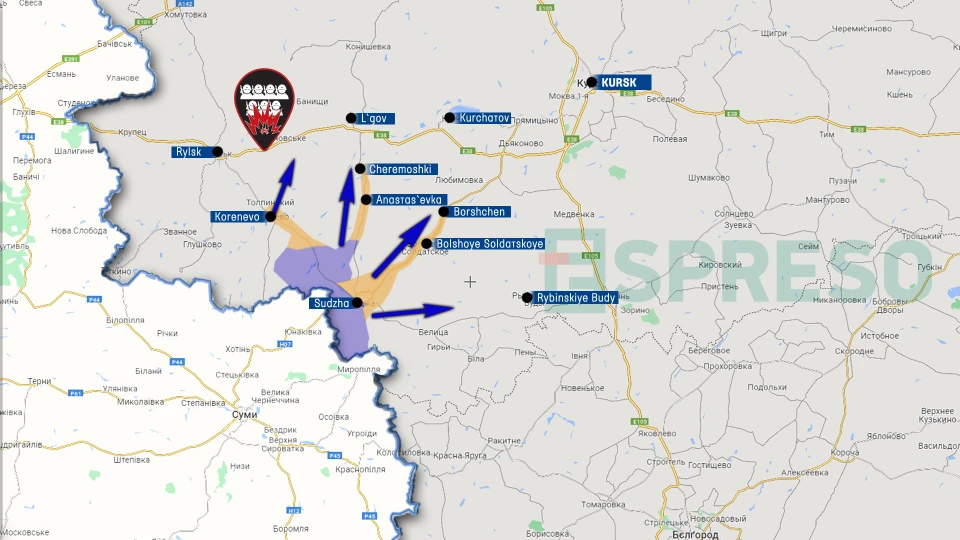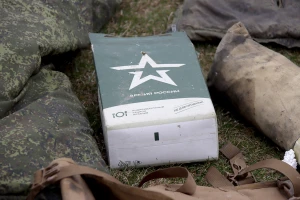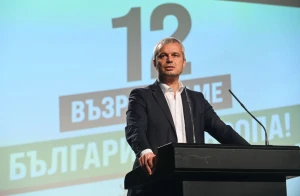
Ukrainian Armed Forces maneuver in four directions in Kursk region. Serhiy Zgurets' column
The Ukrainian Armed Forces are advancing on two fronts towards Lgov and Kursk, while also securing their bridgehead flanks to the west and east, targeting Rylsk and Sudzha
Kursk operation
So, a week has passed since the start of a well-planned operation on Russian territory by an operational maneuver group. This group includes several mechanized and airborne brigades, an artillery brigade, a territorial defense brigade, new ranger regiments, Special Operations Forces, electronic warfare groups, drones, and air defense systems. There are details on all these brigades if you analyze various reports, but it doesn’t make much sense to do so.
The key point is that this group was created for a rapid breakthrough of Russian defenses and to open a new front line. The location, pace of advancement, and well-coordinated interaction between units shocked both the Russians and, seemingly, Ukraine's partners. Additionally, it boosted morale in the Ukrainian Armed Forces and society despite the complexity and risk of this operation.
On August 12, official Kyiv acknowledged that the operation in the Kursk region was being conducted by the Ukrainian Defense Forces. Commander-in-Chief Oleksandr Syrskyi said that Ukrainian troops have already taken control of an area of 1,000 square kilometers in the course of offensive operations in the Kursk region. This was determined by the points where Ukrainian troops operated in various settlements in the Kursk region.
On August 13, the Ukrainian Ministry of Foreign Affairs made statements, with the spokesperson clarifying that Ukraine is not interested in taking the Kursk region as it doesn't seek to claim what isn't theirs. However, the Kursk operation prevents Russia from moving reserves to other fronts and complicates their military logistics. This is a valid conclusion.
In describing the situation in the Kursk region, the Ukrainian Armed Forces continue maneuver operations, maintaining an advantage. Russia is attempting to respond by moving reserves, but this hasn't stabilized the front line. Currently, there isn't a clear front line, as Ukrainian mobile armored groups are breaking through to the rear of Russian units, and its sabotage and reconnaissance teams are covering all areas.
First of all, we are talking about the roads from Rylsk to Kursk, even to the Kursk-Belgorod road in the east. If we look at the map and try to integrate the photo and video reports, we can say that there are four areas where the Ukrainian armed forces are operating.

There are two main directions in the depth of the bridgehead towards Lgov and Kursk, and two more for flanking to secure the bridgehead from the west and east, specifically Rylsk and Sudzha. On the left flank, Ukraine's operational maneuver group is currently advancing towards Rylsk. Russian troops have entrenched in Korenevo, a settlement 25 km from Rylsk, but there is no precise information at this time. Yesterday and the day before, Ukrainian units attempted to bypass Korenevo to get closer to Rylsk.
The two main directions of advancement are Lgov and Kursk. In the direction of Lgov, Ukrainian forces have made progress, with about 17 kilometers remaining to reach the town. The advance towards Kursk is about halfway, with fighting taking place in the village of Martynovka.
This rapid dynamic indicates that Ukraine has achieved tactical and operational successes at this stage. Russia is trying to counter these gains using reserves, but it will be challenging for them as Ukrainian units are simultaneously consolidating positions on key lines.
When it comes to strategic challenges, Ukraine has already secured a victory. It has effectively influenced its partners, demonstrating that with regular and adequate weapon supplies, Ukrainian military leadership can conduct unconventional, asymmetrical operations that shock the enemy. This shock, I believe, is still ongoing.
The key now is how Ukraine leverages this advantage and balance it with actions on other fronts, where the Russians are pressing Ukrainian defenses around Pokrovsk and Toretsk. However, its available forces and resources enable it to carry out offensive operations and find solutions that ensure strategic, informational, operational, and tactical advantages.
By the way, the operation in the Kursk direction is being interpreted differently by various publications seeking details of Ukrainian units' actions. Many reports indicate that Ukrainian forces created conditions where, through electronic warfare systems, they suppressed Russian drones. Ukrainian drones operated in frequency bands where Russia couldn't counter them, allowing them to destroy Russian equipment and personnel.
On UAVs and electronic warfare in Kursk operation
I spoke with Valeriy Borovyk, head of the Alliance New Energy of Ukraine and commander of the strike drone unit White Eagle. He noted that the Kursk operation offers practical insights into drone use. The operation was well-planned, maintaining complete information silence, which allowed for the preparation of electronic warfare systems and the effective use of Ukrainian drones. This coordination between EW and drone units was successful, and Borovyk considers it a model for future operations, emphasizing that it should be applied as a standard in upcoming missions.
The head of the board mentioned that in 2015, his company developed the Vidsich drone with a range of up to 60 km, but it was not put into serial production at that time. Last year, this drone was delivered to the Ukrainian Defense Forces. Currently, the company has produced 500 drones, several systems ready for deployment. Although there is no contract for Vidsich yet, they are confident one will be secured soon. The next step is to train operators to use this system, and the company is ready to deploy these drones to the front lines.
Regarding the Osa drone, a contract has already been signed, and it will be supplied to Ukrainian units by the end of the year. The Osa comes in various versions for special missions, with the classic variant set to be delivered to the Ukrainian Defense Forces within the next three months.
Borovyk emphasized that in collaborating with Western companies, it's crucial to examine and refine their high-budget developments that haven't yet worked effectively in our context, using Ukrainian frontline experience. The government should listen to suggestions from Western companies about creating a specialized unit to work with them directly on the front lines. This unit should not only provide recommendations but also collaborate with Western engineers to improve their systems. Such collaboration could lead to significant success in defending the country and financial benefits for Western companies. This path to effective cooperation needs to be pursued together on the large-scale testing ground that Ukraine currently represents. The Ministry of Defense leaders should heed these recommendations, as Western companies are interested in this collaboration.
- News














































